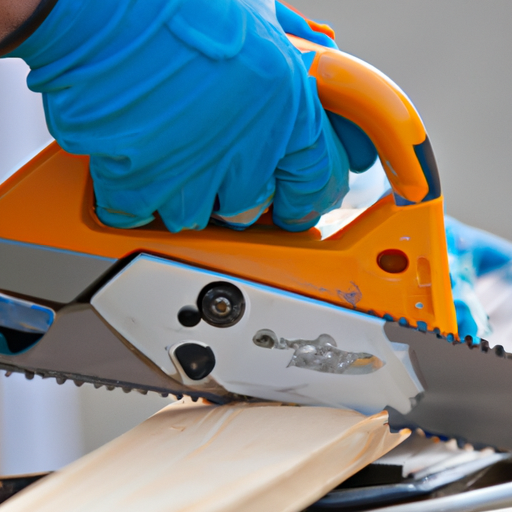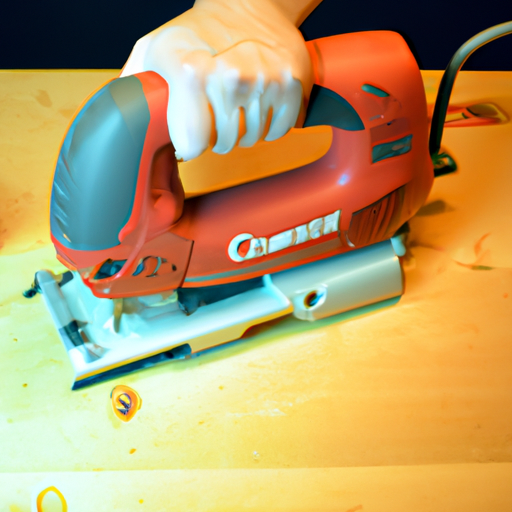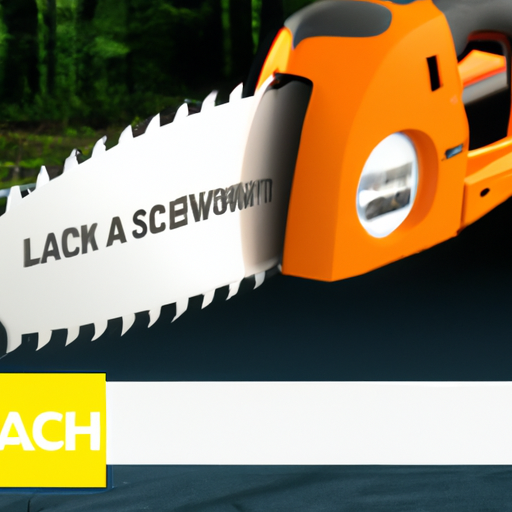Have you ever wondered how to use a battery-powered reciprocating saw safely? Well, wonder no more! We are here to guide you through the process, step by step, so that you can confidently use this powerful tool without any accidents or mishaps.
When it comes to using a battery-powered reciprocating saw, there are a few key safety measures that you need to keep in mind. Firstly, always wear the necessary protective gear such as safety glasses, gloves, and ear protection. This will help protect your eyes, hands, and ears from any potential harm.
Secondly, make sure the saw is turned off and the battery is removed before making any adjustments or changing the blade. This will prevent any accidental starts or injuries while handling the tool. Additionally, always ensure that the blade is properly installed and tightened before using the saw.
In the upcoming article, we will further delve into the various safety precautions that you need to take when using a battery-powered reciprocating saw. We will cover areas such as proper body positioning, how to handle kickback, and how to safely cut through different materials. So, stay tuned and get ready to learn all you need to know about using this handy tool safely.
Choosing the Right Battery-Powered Reciprocating Saw
When it comes to undertaking DIY projects or home renovations, having the right tools is essential. One such tool that can greatly assist in various cutting tasks is a battery-powered reciprocating saw. However, before using this powerful tool, it is important to choose the right one based on your needs and requirements.
Considering the power and speed requirements
The power and speed of a battery-powered reciprocating saw play a crucial role in determining its effectiveness and efficiency. Different models offer varying levels of power and speed, so it is important to consider the tasks you will be performing with the saw. If you anticipate working with tougher materials or larger projects, a saw with higher power and speed capabilities would be ideal.
Evaluating the battery capacity and runtime
Since the reciprocating saw operates on battery power, it is important to consider the battery capacity and runtime. A saw with a longer battery capacity and runtime will ensure that you can complete your tasks without interruptions. Additionally, it is advisable to choose a model with a battery that can be easily recharged or replaced, as this will allow for continuous use of the tool.
Checking for safety features
When it comes to using any power tool, safety should always be a top priority. Therefore, it is crucial to choose a battery-powered reciprocating saw that includes important safety features. These may include a safety lock mechanism, anti-vibration technology, and a blade guard. These safety features will help minimize the risk of accidents and injuries while using the saw.
Inspecting the Saw and Accessories
Before using a battery-powered reciprocating saw, it is important to carefully inspect both the saw and its accessories to ensure they are in proper working condition.
Examining the saw for any damage or defects
Begin by visually inspecting the saw for any signs of damage, such as cracks or missing parts. It is important to address any damage or defects before using the saw, as they can compromise both its performance and safety.
Ensuring the blade is properly installed
Check that the blade is securely and properly installed in the saw. A loose or incorrectly installed blade can lead to poor cutting performance and increase the risk of accidents. Make sure to follow the manufacturer’s instructions for installing and securing the blade.
Inspecting and testing the safety lock mechanism
Verify that the safety lock mechanism on the saw is functioning properly. This mechanism plays a crucial role in preventing accidental starts and securing the blade when not in use. Engage and disengage the safety lock mechanism to ensure it is working correctly before operating the saw.
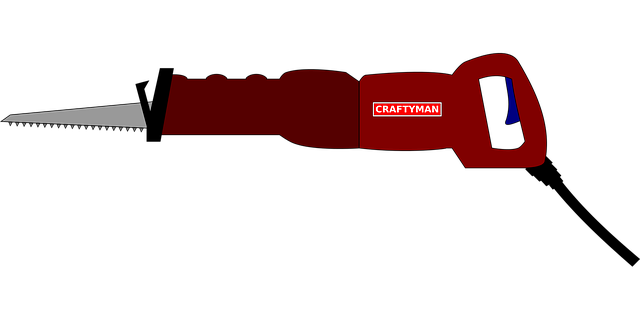
Preparing the Work Area
Once you have inspected the saw and ensured it is in proper working condition, it is time to prepare the work area. This step is essential for creating a safe and efficient environment for using the battery-powered reciprocating saw.
Clearing the workspace of any potential hazards
Before starting any cutting task, clear the workspace of any potential hazards such as debris, tools, or cords. This will provide a clear and safe environment for operating the saw. Additionally, remove any flammable materials from the vicinity to minimize the risk of fire.
Securing the workpiece for stability
For optimal control and safety, it is important to secure the workpiece. This can be done using clamps or other appropriate methods to prevent the material from shifting during cutting. A stable workpiece will help ensure accurate and controlled cuts.
Creating a clear path for the saw’s movement
Before starting the cut, ensure there is a clear path for the saw’s movement. Avoid any obstacles or obstructions that may restrict the saw’s motion. This will allow for smooth and uninterrupted cutting, reducing the risk of accidents and injuries.
Using the Battery-Powered Reciprocating Saw
Now that the work area is prepared, it is time to use the battery-powered reciprocating saw. Following the proper techniques and guidelines will help ensure safe and accurate cuts.
Using the appropriate stance and grip
Maintaining a proper stance and grip is essential for control and stability. Stand with your feet shoulder-width apart, and hold the saw firmly with both hands. Your dominant hand should be placed on the handle, while the other hand supports the front of the saw.
Applying steady and controlled pressure
When using the saw, apply steady and controlled pressure to guide the blade through the material. Avoid using excessive force, as this can lead to loss of control and increase the risk of accidents. Let the blade do the work and allow it to cut at its own pace.
Avoiding excessive force and overexertion
It is important to avoid using excessive force or overexerting yourself while using the battery-powered reciprocating saw. Pushing too hard can cause the blade to bind or kick back, potentially leading to accidents. Work at a comfortable pace and take breaks if needed to prevent fatigue.
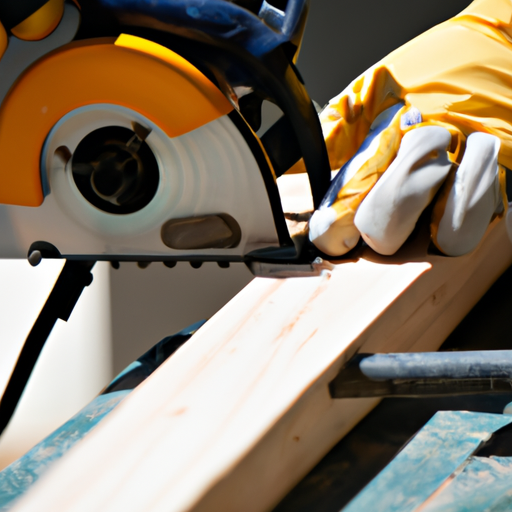
Understanding the Saw’s Cutting Techniques
To effectively use a battery-powered reciprocating saw, it is important to understand and practice different cutting techniques for various types of cuts.
Mastering straight-line cuts
Straight-line cuts are the most common cutting technique used with a reciprocating saw. To achieve a straight cut, align the saw’s blade perpendicular to the material and slowly guide it along the desired cutting line. Take care to maintain control and avoid deviating from the intended path.
Performing curved and angular cuts
When cutting curves or angles, it is important to allow the saw’s blade to follow the desired shape. Move the saw in a slow and controlled manner, adjusting the angle of the blade as needed. Practice on scrap material before attempting any complex curved or angular cuts to ensure accuracy.
Utilizing plunge cutting techniques
Plunge cutting involves starting a cut in the middle of a piece of material, rather than from an edge. This technique is often used for creating openings or making internal cuts. To perform a plunge cut, position the saw’s blade at the desired starting point, engage the safety lock mechanism, and slowly lower the saw into the material.
Implementing Safety Measures
To ensure the safe and proper use of a battery-powered reciprocating saw, it is important to implement certain safety measures.
Wearing appropriate safety gear
Always wear appropriate safety gear, such as safety goggles, a dust mask, and hearing protection, when operating the saw. This will help protect your eyes, ears, and respiratory system from potential hazards such as flying debris and excessive noise.
Using a blade guard and work clamp whenever necessary
When working with a battery-powered reciprocating saw, use a blade guard to protect yourself from accidental contact with the blade. Additionally, use a work clamp or vise to secure the workpiece whenever possible. This will help prevent the material from shifting during cutting, reducing the risk of accidents.
Avoiding contact with the blade or moving parts
During operation, it is crucial to avoid any contact with the blade or moving parts of the saw. Keep your hands and fingers clear of the blade’s path and away from any rotating or moving components. This will help prevent injuries and ensure a safe working environment.
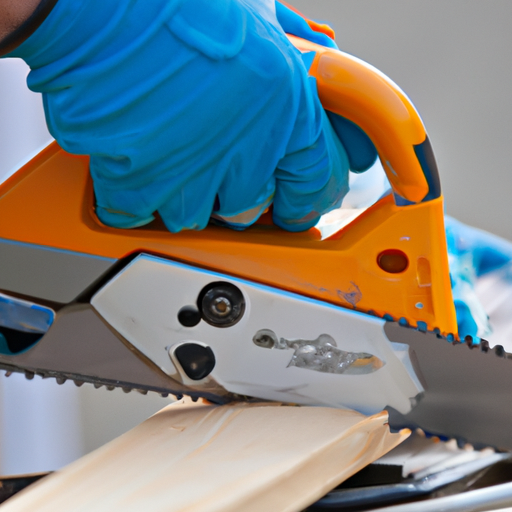
Maintaining the Battery-Powered Reciprocating Saw
Proper maintenance of the battery-powered reciprocating saw is essential for its longevity and optimal performance.
Cleaning and lubricating the saw regularly
Regularly clean the saw to remove any dust, debris, or residue that may accumulate during use. Use a soft brush or cloth to clean both the exterior and interior parts of the saw. Additionally, apply lubricating oil to the necessary components as recommended by the manufacturer to ensure smooth operation.
Checking and replacing worn-out blades
Inspect the saw’s blades regularly for signs of wear or damage. Worn-out or damaged blades can reduce cutting efficiency and increase the risk of accidents. Replace any blades that are dull, chipped, or bent to ensure safe and effective cutting.
Charging and storing the battery correctly
When not in use, it is important to charge the saw’s battery according to the manufacturer’s instructions. Overcharging can shorten the battery’s lifespan, while undercharging can affect its performance. Additionally, store the saw and its battery in a cool and dry place to prevent damage and maintain their integrity.
Avoiding Common Mistakes
To ensure safe and efficient use of a battery-powered reciprocating saw, it is important to avoid common mistakes that can lead to accidents or damage.
Ignoring safety precautions
One of the most common mistakes is disregarding safety precautions. Always adhere to the safety guidelines provided by the manufacturer and use appropriate protective gear. Ignoring safety precautions can lead to serious injuries or accidents.
Using the wrong type of blade for the material
Using the wrong type of blade for the material being cut can result in poor cutting performance and potential damage to the saw or workpiece. It is important to select the appropriate blade for the specific material to be cut, whether it be wood, metal, or other materials.
Failing to secure the workpiece properly
Neglecting to secure the workpiece properly can lead to inaccurate cuts and hazardous situations. Always secure the workpiece using clamps or other appropriate methods to ensure stability and avoid the material shifting during cutting.
Troubleshooting and Problem-Solving
Even with proper use and maintenance, issues may arise while using a battery-powered reciprocating saw. It is important to be able to identify and address common problems that may be encountered.
Identifying and addressing common issues
Common issues with a battery-powered reciprocating saw may include loss of power, blade slipping, or excessive vibration. If any of these problems occur, ensure that the battery is charged, tighten the blade securely, and inspect the saw for any loose or damaged parts. If the issue persists, consult the manufacturer’s troubleshooting guide or seek professional assistance.
Resolving power or battery-related problems
If the saw’s power or battery seems to be malfunctioning, check that the battery is properly inserted and charged. If the battery connections are clean and secure, and the saw is still not functioning properly, the battery may need to be replaced. Refer to the manufacturer’s guidelines for proper battery replacement.
Seeking professional assistance, if needed
If you encounter any issues or problems with your battery-powered reciprocating saw that you are unable to resolve on your own, it is advisable to seek professional assistance. A qualified professional can provide expert guidance and ensure that your saw is in proper working condition.
Conclusion
Using a battery-powered reciprocating saw can greatly simplify and enhance your cutting tasks. However, it is essential to prioritize safety at all times. By choosing the right saw, inspecting it and its accessories, preparing the work area, using the saw correctly, implementing safety measures, maintaining the saw properly, avoiding common mistakes, and effectively troubleshooting any issues, you can ensure the safe and efficient use of a battery-powered reciprocating saw. Remember to always follow the manufacturer’s guidelines, wear appropriate safety gear, and continuously educate yourself on safe practices. By doing so, you can reap the benefits of this versatile tool while minimizing the risk of accidents and injuries.
